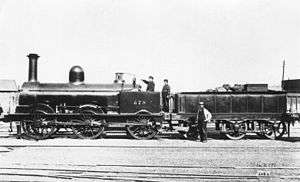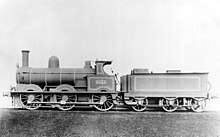LNWR DX Goods class
The London and North Western Railway (LNWR) DX Goods class was a class of 0-6-0 steam locomotive, designed by John Ramsbottom for freight duties. 943 were constructed making them the largest single class of steam locomotives built in the United Kingdom. Despite this, none were preserved.
| LNWR DX Goods Class [1] [2] | |||||||||||||||||||||||||||||
|---|---|---|---|---|---|---|---|---|---|---|---|---|---|---|---|---|---|---|---|---|---|---|---|---|---|---|---|---|---|
 No. 578 in original condition and livery | |||||||||||||||||||||||||||||
| |||||||||||||||||||||||||||||
| |||||||||||||||||||||||||||||
| |||||||||||||||||||||||||||||
| |||||||||||||||||||||||||||||
History

The "DX" goods engine was the first original design produced by Ramsbottom, shortly after becoming Locomotive Superintendent of the Northern Division. An experimental prototype was developed at Longsight whilst Ramsbottom was only in charge of the North-Eastern Division.[1] The first regular example was completed at Crewe in September 1858, and was given the running number 355. This was the 399th locomotive built at Crewe, but it was the practice of the LNWR to reuse the numbers of withdrawn locomotives.[1]
The first DX, No. 355, was named Hardman, and carried the name on a curved brass plate above the driving wheels. It was painted in the same dark green livery as used by Ramsbottom's predecessor, Francis Trevithick, but edged with a single black line. Fifty-four of the early DX locomotives were given names, but all were removed by 1864, with some re-used on passenger locomotives.
Four 0-4-2 versions of this locomotive type were built by Robert Stephenson and supplied to the Sydney Railway Company in 1855 as the first motive power for the new railway company. They were virtually identical in specification, except for slightly larger driving wheels at 5 ft 6 in (1.676 m) diameter and cylinders being a smaller 16-inch (410 mm) bore than the 17 in (432 mm) of the original design.
| LNWR No. | Name | Crewe Works No. | Date built | Notes |
|---|---|---|---|---|
| 355 | Hardman | 399 | Sep 1858 | |
| 357 | Terrier | 400 | Sep 1858 | |
| 358 | Falstaff | 401 | Oct 1858 | |
| 359 | Glowworm | 403 | Nov 1858 | |
| 87 | Eden | 404 | May 1859 | |
| 39 | Tantalus | 405 | May 1859 | |
| 428 | Trevithick | 406 | May 1859 | |
| 429 | Roberts | 407 | May 1859 | |
| 447 | Whitworth | 408 | May 1859 | |
| 210 | Alchymist | 409 | Jun 1859 | |
| 369 | Banshee | 410 | Jun 1859 | |
| 240 | Bee | 418 | Oct 1859 | |
| 120 | Samson | 419 | Nov 1859 | |
| 261 | Hercules | 420 | Nov 1859 | |
| 266 | Sutherland | 422 | Nov 1859 | |
| 245 | Ellesmere | 423 | Nov 1859 | |
| 206 | Menai | 432 | Apr 1860 | |
| 531 | Lady of the Lake | 433 | Apr 1860 | Renumbered 494 and name removed in Feb 1862 |
| 345 | Turk | 434 | Apr 1860 | |
| 215 | Spitfire | 435 | Apr 1860 | |
| 283 | Croxteth | 436 | Apr 1860 | |
| 296 | Bellerophon | 437 | May 1860 | |
| 293 | Quick Silver | 438 | May 1860 | |
| 312 | Tubal | 439 | May 1860 | |
| 192 | Hero | 444 | Aug 1860 | |
| 211 | Onyx | 445 | Aug 1860 | |
| 220 | Waterloo | 446 | Aug 1860 | |
| 221 | Trafalgar | 448 | Aug 1860 | |
| 52 | Diomed | 449 | Sep 1860 | |
| 2 | Hecla | 450 | Sep 1860 | |
| 237 | Blenheim | 451 | Sep 1860 | |
| 121 | Buffalo | 452 | Sep 1860 | |
| 123 | Victory | 453 | Sep 1860 | |
| 183 | Theorem | 454 | Sep 1860 | |
| 177 | Chimera | 455 | Sep 1860 | |
| 216 | Ambassador | 456 | Oct 1860 | |
| 224 | Violet | 469 | Feb 1861 | |
| 280 | Glendower | 470 | Feb 1861 | |
| 278 | Locke | 471 | Feb 1861 | |
| 442 | Forerunner | 479 | Mar 1861 | |
| 236 | Hawkstone | 483 | Apr 1861 | |
| 356 | Memnon | 485 | Apr 1861 | |
| 568 | Stewart | 498 | Aug 1861 | |
| 129 | Martin | 510 | Sep 1861 | |
| 65 | Charon | 513 | Oct 1861 | |
| 125 | Soho | 522 | Nov 1861 | |
| 130 | Heron | 523 | Nov 1861 | |
| 325 | Chandos | 547 | May 1862 | |
| 147 | Woodlark | 548 | May 1862 | |
| 135 | Bat | 549 | May 1862 | |
| 343 | Etna | 550 | May 1862 | |
| 368 | Majestic | 551 | May 1862 | |
| 34 | Phoebus | 552 | May 1862 | |
| 532 | Grasmere | 553 | May 1862 | |
857 examples of Ramsbottom’s standard goods design were built for the LNWR at Crewe works between 1858 and 1872.[4][5] The class has been described as ‘the earliest example of standardization and mass productions of locomotives on a large scale,'[6] and ‘a remarkable instance of standardisation at a time when most railways had many different classes, each class with only few engines.’.[2] During the 1870s driving cabs were added. 278 examples of a saddle tank version of the design were built after 1870, known as the LNWR Special Tank.
In addition to the 857 examples used by the LNWR, a further 86 examples of the original design were constructed at Crewe for the Lancashire and Yorkshire Railway between 1871 and 1874.[1] This alarmed independent locomotive manufacturers, who sought an injunction to stop the practice;[7] granted on 16 December 1875.[8] In April 1881 Francis Webb rebuilt 500 examples with a new 150 psi boiler and vacuum brakes for working passenger trains. These became known as ‘Special’ (or vacuum) DX’s.[9]
Accidents and incidents
- On 12 January 1899, locomotive 1418 was hauling a freight train that was derailed at Penmaenmawr, Caernarfonshire due to the trackbed being washed away in a storm. Both locomotive crew were killed.[10]
Withdrawals
Withdrawals began in 1902 but there were still 88 in existence on the formation of the London Midland and Scottish Railway in 1923. The last survivor was withdrawn in 1930.[11] Despite the large number of the Class produced, all were scrapped.
Engines sold abroad
Between 1900 and 1901, four LNWR Special DX were sold to the Société Anonyme du Chemin de Fer International de Malines à Terneuzen, a private railway between Belgium and the Netherlands.[12] They were renumbered 15, 16, 17 and 18.[13] Three of them were rebuilt between 1910 and 1911 with larger cabs of Belgian[14] design and all of them were fitted with Westinghouse brakes sometimes after 1911. One of them (number 15) was still on the active roster in 1948 when the Malines - Terneuzen was taken over by SNCB. All the M.T. engines were then scrapped.[15]
References
- Nock, O.S. (1952). The Premier Line - The Story of London & North Western Locomotives. London: Ian Allan. pp. 51–53.
- London and North Western Railway Society (1999). "Goods Engines of LNWR: DX". Retrieved 6 June 2012.
- Baxter 1978, pp. 124–130.
- Baxter 1977, p. 12.
- Baxter 1978, pp. 124–157.
- Casserley, H.C. (1960). Historic locomotive pocket book. London: Batsford. pp. 124–157.
- Kris Ward (2004). "The Locomotive Manufacturers Association". Leeds Engine Builders. Retrieved 2 January 2014.
- National Railway Museum (1997). "Records of the Locomotive Manufacturers' Association" (PDF). p. 7. Retrieved 2 January 2014.
ORDER in Perpetual Injunction in case of Attorney General ... against London & North Western Railway Co & Richard Moon ... restraining latter from manufacturing locomotive engines or other rolling stock for sale or hire on other than their own railway, 16 Dec 1875
- London and North Western Railway Society (1999). "Goods Engines of LNWR: Special DX". Retrieved 6 June 2012.
- Trevena 1981, pp. 16–17.
- Casserley & Johnston 1974, p. 7.
- Society, LNWR. "Where and When? - Part 3 - LNWR Society Journal - September 2002". www.lnwrs.org.uk. Retrieved 16 December 2017.
- "Douzième période, 1948-1967 – Reprise des dernières compagnies et dernières (...) - Rixke Rail's Archives". rixke.tassignon.be (in French). Retrieved 16 December 2017.
- "TWO B&W PHOTOS EX – LNWR DX 0-6-0 MALINES – TERNEUZEN RAILWAY, BELGIUM/HOLLAND | #463667093". Worthpoint. Retrieved 16 December 2017.
- "Douzième période, 1948-1967 – Reprise des dernières compagnies et dernières (...) - Rixke Rail's Archives". rixke.tassignon.be (in French). Retrieved 16 December 2017.
- Baxter, Bertram (1977). Baxter, David (ed.). British Locomotive Catalogue 1825–1923, Volume 1: General Summary and Index of Locomotive-Owning Companies. Hartington, Derbyshire: Moorland Publishing Company. ISBN 0-903485-50-8.
- Baxter, Bertram (1978). Baxter, David (ed.). British Locomotive Catalogue 1825–1923, Volume 2A: London and North Western Railway and its constituent companies. Ashbourne, Derbyshire: Moorland Publishing Company. ISBN 0-903485-51-6.
- Casserley, H. C. & Johnston, Stuart W. (1974) [1966]. Locomotives at the Grouping 3: London, Midland and Scottish Railway. Shepperton, Surrey: Ian Allan. ISBN 0-7110-0554-0.
- Nock, O.S. (1952). The Premier Line – The Story of London & North Western Locomotives. London: Ian Allan Ltd.CS1 maint: ref=harv (link)
- Trevena, Arthur (1981). Trains in Trouble: Vol. 2. Redruth: Atlantic Books. ISBN 0-906899-03-6.CS1 maint: ref=harv (link)